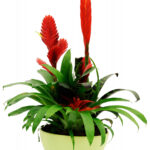Bromelia Plant: Everything You Need to Know
What do you mean by Bromelia Plant?
The Bromelia plant is a type of tropical plant that belongs to the Bromeliaceae family. It is known for its vibrant colors, unique shape, and ability to thrive in a variety of environments. This plant is native to Central and South America, where it can be found growing in forests, savannas, and even on rocky cliffs.
How does the Bromelia Plant grow?

The Bromelia plant grows in a rosette pattern, with leaves that form a central cup or tank. This cup collects water and acts as a reservoir for the plant, providing it with a constant source of hydration. The plant’s roots are mainly used for anchoring it to its growing surface, rather than absorbing water and nutrients.
What is known about the Bromelia Plant?
One of the most well-known characteristics of the Bromelia plant is its ability to attract and trap insects. The plant’s central cup collects water, which serves as a breeding ground for small insects. The insects are then lured into the cup by the plant’s bright colors and sweet scent, where they become trapped and eventually decompose, providing the plant with additional nutrients.
How to care for a Bromelia Plant?
Caring for a Bromelia plant is relatively easy, as it is a low-maintenance plant that requires minimal attention. It thrives in bright, indirect light and prefers temperatures between 60-80 degrees Fahrenheit. The plant should be watered directly into its central cup, allowing it to collect water and self-watering. It is important to avoid overwatering the plant, as this can lead to root rot.
How to propagate a Bromelia Plant?
Bromelia plants can be propagated by collecting and replanting their offsets, or pups. These pups typically grow at the base of the mother plant and can be separated once they have developed their own root system. The pups should be planted in a well-draining soil mix and kept in a warm, humid environment until they establish roots.
What are the different varieties of Bromelia Plant?
There are over 3,000 different species of Bromelia plants, each with its own unique characteristics and appearance. Some popular varieties include the Guzmania, Neoregelia, and Tillandsia. These plants come in a wide range of colors, shapes, and sizes, making them a popular choice for indoor and outdoor gardens.
Conclusion
In conclusion, the Bromelia plant is a fascinating and beautiful addition to any garden or indoor space. Its unique growth pattern, vibrant colors, and ability to attract insects make it a standout plant that is sure to impress. With proper care and attention, the Bromelia plant can thrive and bring joy to any plant lover.
FAQs
1. Can Bromelia plants be grown indoors?
Yes, Bromelia plants can be grown indoors as long as they receive enough bright, indirect light.
2. How often should I water my Bromelia plant?
Bromelia plants should be watered directly into their central cup, and the cup should be kept filled with water at all times.
3. How do I know if my Bromelia plant is getting enough light?
If your Bromelia plant’s leaves are turning yellow or brown, it may not be getting enough light. Move it to a brighter location to see if it improves.
4. Can Bromelia plants be grown in soil?
Bromelia plants are epiphytic, meaning they do not require soil to grow. They can be grown in a well-draining soil mix or mounted on a piece of wood or bark.
5. Is the Bromelia plant toxic to pets?
Bromelia plants are non-toxic to pets, making them a safe and pet-friendly plant to have in your home.
